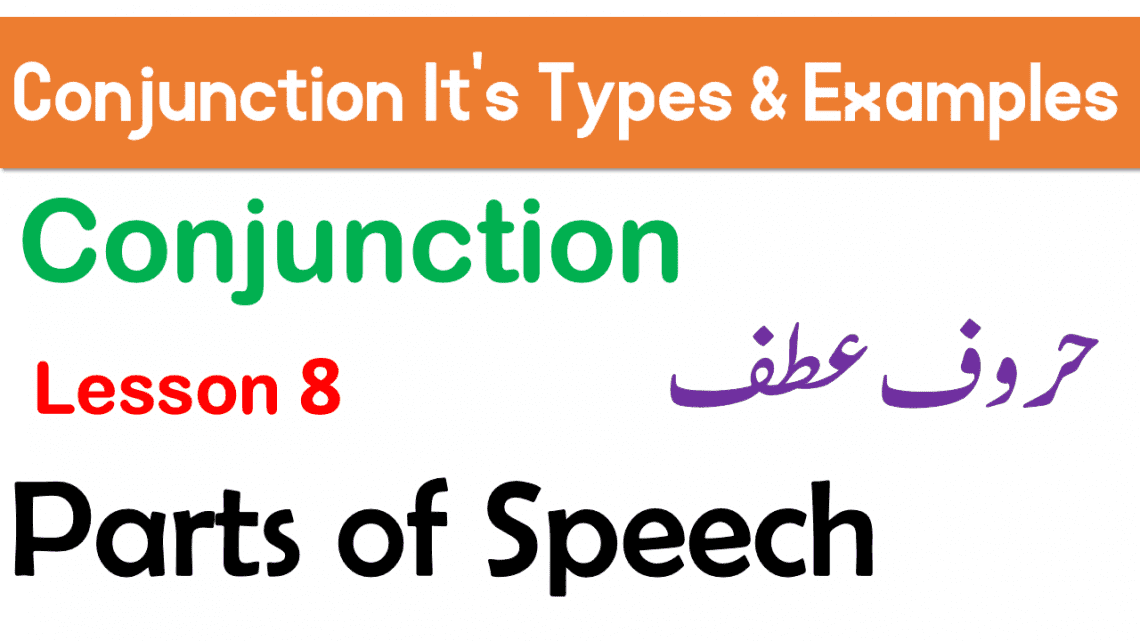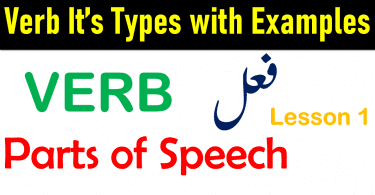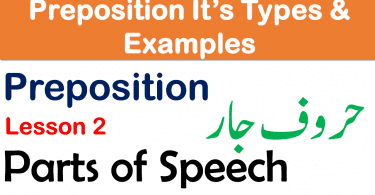Conjunctions are the connecting words that join phrases, clauses, and ideas in English. Many learners struggle to understand how to use them correctly, especially when switching between English and Urdu. In this blog post, you’ll learn the main types of conjunctions with clear Urdu meanings, helping you build strong sentence structure and fluency. To strengthen your foundation, explore more lessons in grammar.
Table of Contents
What are Conjunctions?
Conjunctions are words that join two or more words, phrases, or sentences. They help connect ideas and make sentences smoother.
وہ الفاظ جو دو یا دو سے زیادہ الفاظ، جملوں یا خیالات کو آپس میں جوڑتے ہیں۔
List of Conjunctions with Urdu Meanings
| English Conjunction | Urdu Meaning |
|---|---|
| and | اور |
| or | یا |
| but | لیکن |
| because | کیونکہ |
| if | اگر |
| till | جب تک |
| when | جب |
| although | اگرچہ |
| so that | تاکہ |
| lest | کہیں ایسا نہ ہو |
| not only…but also | نہ صرف…بلکہ |
| either…or | یا…یا |
| neither…nor | نہ…نہ |
| as soon as | جونہی |
| since | چونکہ |
| for | کیونکہ |
| that | کہ |
| therefore | اس لیے |
| otherwise/or else | ورنہ |
| not to speak of…even | کا تو ذکر ہی کیا، حتیٰ کہ |
Types of Conjunctions
There are three main types of conjunctions—Coordinating, Subordinating, and Correlative—each serving a different purpose in sentence construction.
1. Coordinating Conjunctions
These conjunctions connect words, phrases, or independent clauses of equal grammatical rank.
- Ahmed is present and Talha is present too.
احمد حاضر ہے اور طلحہ بھی۔ - I like milk but I don’t like tea.
مجھے دودھ پسند ہے لیکن چائے نہیں۔ - Work hard, or you will fail.
محنت کرو ورنہ فیل ہو جاؤ گے۔
2. Subordinating Conjunctions
These conjunctions link an independent clause with a dependent clause, showing cause, condition, time, purpose, etc.
- I can’t go because I am busy.
میں نہیں جا سکتا کیونکہ میں مصروف ہوں۔ - If you study hard, you will pass.
اگر تم محنت کرو گے، تو کامیاب ہو گے۔ - He works hard so that he may pass.
وہ محنت کرتا ہے تاکہ وہ پاس ہو جائے۔ - Although he is rich, yet he is miser.
اگرچہ وہ امیر ہے لیکن کنجوس ہے۔ - Lest we miss the bus, hurry up!
کہیں ایسا نہ ہو کہ ہم بس سے رہ جائیں۔
3. Correlative Conjunctions
These are paired conjunctions used to join equal sentence elements and show a relationship.
- Either you or Asif has stolen my book.
یا تم نے یا آصف نے میری کتاب چرائی ہے۔ - Neither I nor Asif is guilty.
نہ میں نہ ہی آصف قصور وار ہے۔ - He is not only honest but also sincere.
وہ نہ صرف ایماندار ہے بلکہ مخلص بھی ہے۔ - The more you practice, the more you improve.
جتنا زیادہ مشق کرو گے، اتنا ہی بہتر ہو گے۔ - He is not so brave as his brother is.
وہ اتنا بہادر نہیں جتنا اس کا بھائی ہے۔
Mastering the types of conjunctions—coordinating, subordinating, and correlative—enhances sentence clarity and flow. Their proper use improves both writing and speaking by connecting ideas seamlessly.
Use of Conjunctions in Sentences
And (اور)
Used to connect similar ideas or actions.
- Ahmed is present and Talha is present too.
احمد حاضر ہے اور طلحہ بھی - Ali and Asif went to school.
علی اور آصف سکول گئے
But (لیکن)
Used to show contrast between two ideas.
- Ahmed is present but Talha is absent.
احمد حاضر ہے لیکن طلحہ غیر حاضر ہے - I like milk but I don’t like tea.
مجھے دودھ پسند ہے لیکن مجھے چائے پسند نہیں
As well as (اور بھی)
Used to add more information with emphasis.
- He is intelligent as well as hardworking.
وہ ذہین بھی ہے اور محنتی بھی ہے - Ali as well as Ahmed is absent.
علی بھی غیر حاضر ہے اور احمد بھی
That (کہ)
Used to introduce a clause.
- He said that he was busy.
اس نے کہا کہ وہ مصروف تھا - She says that she is tired.
وہ کہتی ہے کہ وہ تھکی ہوئی ہے
Therefore (اسی لیے)
Used to show a reason and result.
- I am ill therefore I can’t come to school.
میں بیمار ہوں اس لیے میں سکول نہیں آ سکتا - He has no money therefore I paid the bill.
اس کے پاس پیسے نہیں تھے اس لیے میں نے بل ادا کیا
Otherwise / Or else (ورنہ)
Used to give warning or consequence.
- Work hard otherwise you will fail.
محنت کرو ورنہ فیل ہو جاؤ گے - Take care of your health or else you will fall ill.
اپنی صحت کا خیال رکھو ورنہ تم بیمار ہو جاؤ گے
Asked……if (پوچھا آیا کہ)
Used to report questions indirectly.
- He asked me if I was OK.
اس نے مجھ سے پوچھا آیا کہ میں ٹھیک ہوں - He asked him if he had been there.
اس نے اس سے پوچھا آیا کہ وہ وہاں تھا
Either / Neither…..nor (یا / نہ)
Used to show alternatives or negations.
- Either you or Asif has stolen my book.
یا تم نے میری کتاب چرائی ہے یا آصف نے - Neither I nor Asif has stolen your book.
نہ میں نے اور نہ ہی آصف نے آپ کی کتاب چرائی ہے
Because / Since / As / For (کیونکہ / چونکہ)
Used to show cause and reason.
- I can’t go because I am busy.
میں نہیں جا سکتا کیونکہ میں مصروف ہوں - As I was free, I went there.
چونکہ میں فارغ تھا اس لیے میں وہاں چلا گیا
Although…..yet (اگرچہ، لیکن پھر بھی)
Used to contrast two ideas.
- Although he is rich, yet he is miser.
اگرچہ وہ امیر ہے لیکن پھر بھی کنجوس ہے - Although she is poor, yet she is honest.
اگرچہ وہ غریب ہے لیکن پھر بھی ایماندار ہے
As soon as (جونہی)
Used to express immediate actions.
- As soon as I reached home, it began to rain.
جونہی میں گھر پہنچا بارش شروع ہو گئی - As soon as the bell rang, students ran out.
جونہی گھنٹی بجی، بچے باہر بھاگے
Lest (کہیں ایسا نہ ہو)
Used to express fear of a negative outcome.
- Work hard lest you should fail.
محنت کرو کہیں ایسا نہ ہو کہ تم فیل ہو جاؤ - Work fast lest we should miss the bus.
تیزی سے کام کرو کہیں ایسا نہ ہو کہ ہم بس سے رہ جائیں
Not only…..but also (نہ صرف۔۔۔۔۔۔۔بلکہ)
Used to emphasize two qualities/actions.
- He is not only honest but also sincere.
وہ نہ صرف ایماندار ہے بلکہ مخلص بھی ہے - She is not only beautiful but also intelligent.
وہ نہ صرف خوبصورت ہے بلکہ ذہین بھی ہے
So that…….may (تاکہ)
Used to show purpose.
- He works hard so that he may pass.
وہ محنت کرتا ہے تاکہ وہ پاس ہو جائے - I go there so that I may take exercise.
میں وہاں جاتا ہوں تاکہ میں ورزش کر سکوں
Not to speak of……even (تو درکنار/کا تو ذکر ہی کیا)
Used to emphasize how little someone has or gets.
- Not to speak of milk, he does not even get bread.
دودھ کا تو ذکر ہی کیا، اسے تو روٹی بھی نہیں ملتی - Not to speak of a car, he does not even have a bike.
کار کا تو ذکر ہی کیا، اس کے پاس تو موٹر سائیکل بھی نہیں ہے
The more….the more (جتنا۔۔۔۔۔۔۔اتنا)
Used to show proportional relationship.
- The higher we go, the cooler it is.
ہم جتنا اوپر جاتے ہیں، اتنی ہی ٹھنڈ ہوتی ہے - The more the sugar, the sweeter it is.
جتنا زیادہ چینی ہو گی، اتنا ہی زیادہ میٹھا ہو گا
Not so……as (اتنا نہیں ۔۔۔۔۔ جتنا کہ)
Used to compare qualities in a negative way.
- He is not so brave as his brother is.
وہ اتنا بہادر نہیں ہے جتنا اس کا بھائی ہے - He is not so wise as his friend is.
وہ اتنا عقلمند نہیں ہے جتنا اس کا دوست ہے
Conclusion
Understanding conjunctions is essential for building clear and grammatically correct sentences. By learning the types of conjunctions with examples in Urdu, English learners can improve both their writing and speaking skills. Mastering these small but powerful words makes your language more fluent and connected.
You May Also Like



